

Consolidated B-24 Liberator" The Consolidated B-24 Liberator, a large bomber, was the most prolific American plane of World War II, with more than 18,000 built.

It was in great demand for a wide variety of roles, including carrying cargo and passengers, antisubmarine work, bombing, reconnaissance, and special operations. Its name will be forever linked with the brilliant but costly August 1943 USAAF raids on the Ploesti oil fields in Rumania. Classic Airplane Image Gallery. Consolidated B-24D Liberator. Boeing B-29 Superfortress. The B-29 Superfortress is a four-engine propeller-driven heavy bomber designed by Boeing that was flown primarily by the United States toward the end of World War II and during the Korean War.

It was one of the largest aircraft to have seen service during World War II and a very advanced bomber for its time, with features such as a pressurized cabin, an electronic fire-control system, and remote-controlled machine-gun turrets. B-29 Superfortress. Boeing submitted the prototype for the B-29 long-range heavy bomber to the Army in 1939, before the United States entered World War II.
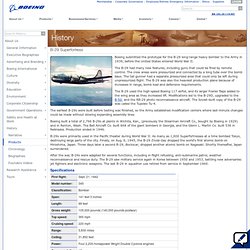
The B-29 had many new features, including guns that could be fired by remote control. The crew areas were pressurized and connected by a long tube over the bomb bays. The tail gunner had a separate pressurized area that could only be left during unpressurized flight. Boeing B-29 Superfortress. Boeing B-29 Superfortress - Manufacturer was Boeing Aircraft Company. New Orleans: Collections: Artifacts: Norden Bombsight. The Norden Bomb Sight. Norden M-9 Bombsight. The Norden bombsight was crucial to the success of the U.S.
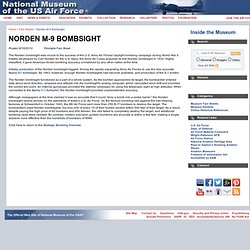
Army Air Forces' daylight bombing campaign during World War II. Initially developed by Carl Norden for the U.S. Navy, the Army Air Corps acquired its first Norden bombsight in 1932. Highly classified, it gave American forces bombing accuracy unmatched by any other nation at the time. Initially, production of the Norden bombsight lagged, forcing the rapidly expanding Army Air Forces to use the less accurate Sperry S-1 bombsight. Norden bombsight. The Norden bombsight at the Computer History Museum in Mountain View, California.
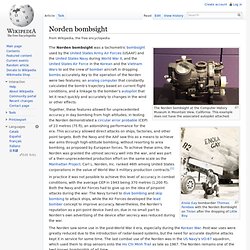
This example does not have the associated autopilot attached. The Norden bombsight was a tachometric bombsight used by the United States Army Air Forces (USAAF) and the United States Navy during World War II, and the United States Air Force in the Korean and the Vietnam Wars to aid the crew of bomber aircraft in dropping bombs accurately. Key to the operation of the Norden were two features; an analog computer that constantly calculated the bomb's trajectory based on current flight conditions, and a linkage to the bomber's autopilot that let it react quickly and accurately to changes in the wind or other effects.
Together, these features allowed for unprecedented accuracy in day bombing from high altitudes; in testing the Norden demonstrated a circular error probable (CEP) of 23 metres (75 ft), an astonishing performance for the era. History[edit] Early work[edit] First bombsight design[edit] Bombing of Hiroshima and Nagasaki - World War II. Hiroshima, a manufacturing center of some 350,000 people located about 500 miles from Tokyo, was selected as the first target.
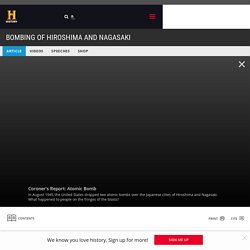
After arriving at the U.S. base on the Pacific island of Tinian, the more than 9,000-pound uranium-235 bomb was loaded aboard a modified B-29 bomber christened Enola Gay (after the mother of its pilot, Colonel Paul Tibbets). The plane dropped the bomb–known as “Little Boy”–by parachute at 8:15 in the morning, and it exploded 2,000 feet above Hiroshima in a blast equal to 12-15,000 tons of TNT, destroying five square miles of the city. Hiroshima’s devastation failed to elicit immediate Japanese surrender, however, and on August 9 Major Charles Sweeney flew another B-29 bomber, Bockscar, from Tinian. Atomic Bomb. At approximately 8.15am on 6 August 1945 a US B-29 bomber dropped an atomic bomb on the Japanese city of Hiroshima, instantly killing around 80,000 people.
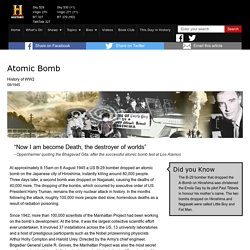
By the Numbers: World War II's atomic bombs. An atomic bomb of the 'Little Boy' type, which was detonated over Hiroshima, Japan 68 years ago.

The first atomic bomb was used in battle 68 years ago in Hiroshima, JapanNearly 200,000 people were killed, including those who died in the aftermathMore than 70,000 were killed by the second bomb dropped three days later (CNN) -- The decision by the United States to use the atomic bomb against Japan in August 1945 is credited with ending World War II. Here is some background information about the history of the atomic bomb, by the numbers: 2 - Number of atomic bombs dropped on Japan during World War II. 80,000 - People who died instantly in Hiroshima, Japan, on August 6, 1945, when the first ever atomic bomb was used in war.